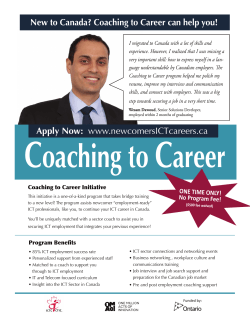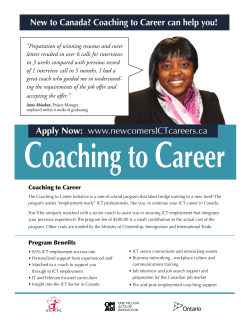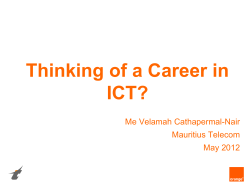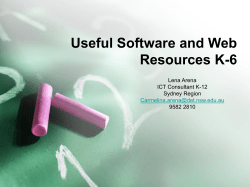
Document 415425
The Risk IMYC mind map Learning Goals Learning Goals Learning Goals Students will: Students will: Students will: 4.1 Know that the study of ICT is concerned with applying technology to gather, use and exchange information 4.1 Know that technology is concerned with designing and making systems that aid the needs of a society 4.1 Know that the study of art is concerned with visual, tactile and personal expression used to share and express emotions, ideas and values 4.2 Know about an increasing number of applications of ICT for work, communication and leisure 4.3 Know how to combine creativity with skills to predict new ideas and inventions 4.2 Know the contributions and impacts of various artists in different countries and how their work influenced or was influenced by society 4.3 Be able to use ICT safely, responsibly and respectfully 4.9 Be able to test and evaluate the construction of their own work and improve on it 4.3 Know how art, history and culture are interrelated and reflected through one another over time 4.10Be able to investigate the way in which simple products in everyday use are designed and made and how they work 4.4 Be able to recognise influential artists from particular countries, genres or periods and the pieces of art they produced 4.12 Develop an understanding of how technology can be used to meet needs, wants and opportunities 4.5 Be able to evidence how artists, craftspeople and designers from a variety of traditions from around the world use materials, forms and techniques to express their feelings, observations and experiences 4.4 Be able to gather and interrogate information by framing questions appropriately Each unit is incorporated and summarised within a mind map. This poster is for the unit ‘Risk’. You will see that the overview of what your students will be doing in each subject is closely connected both to the theme and the Big Idea and to the precise Learning Goals of each subject. You will find a comprehensive list of the Learning Goals in the Teachers’ File. The Teachers’ File also contains mind maps of every unit of the IMYC. The mind maps are really helpful in making sure that every teacher knows how their colleagues are helping students learn too. Throughout every unit and in every subject, there are opportunities to assess the progression of your students’ skills. Learning Goals in bold denote key skills which correspond to rubrics in the IMYC Assessment for Learning Programme. 4.8 Be able to exchange information and ideas in a number of different ways 4.9 Be able to use ICT to plan and control events Learning Goals Students will: 4.6 Be able to use the elements of art and principles of design to discuss and critique works of art showing understanding, respect and enjoyment as appropriate 4.6 Know about a range of views, cultures and traditions 4.7 Be able to consider and respect the views, cultures and traditions of other people ICT 4.20 Know about and respect alternative moral standpoints The risks involved in using ICT in all of its forms are many, complex and constantly evolving as technology advances. This subject section is about the risks that exist when we use ICT and why your students need to be aware of the risks and how to deal with them. However, the overarching theme of this subject section is one which focuses on progress – how the use of ICT makes our lives better, allows us to interact more easily and efficiently, either for financial or social reasons, and how the risk factors may prevent this. A good overview of the issues involved can be found at the Know IT All website provided by Childnet International (www.childnet-int.org/kia/secondary). Within this subject section there are a lot of opportunities to focus upon and discuss the dangers of ‘grooming’ young people using online communication as well as the potential risks to young people when they access inappropriate materials either deliberately or accidentally. Clearly these matters need to be addressed sensitively and the online resources in the second research activity of ICT Task 1 are a comprehensive guide to the information your students need to be aware of. The final task in this subject section concentrates on the mechanics of security, namely encryption and passwords which are the methods by which information being transmitted or stored is made secure. The danger or harm mentioned in the Big Idea of Risk occurs when, while attempting to make progress when transmitting information, we expose ourselves to hackers intercepting our communications. 4.21 Be able to develop their own moral standpoints The International Middle Years Curriculum A curriculum for 11-14 year-olds from Fieldwork Education 4.24 Be better able to recognise their value as individuals T: +44 (0)20 7531 9696 F: +44 (0)20 7531 1333 E: info@imyc.org 4.44 Be able to act in accordance with the needs of other people, other living things and the environment www.internationalmiddleyearscurriculum.com 4.7 Be able to create an original work of art using a variety of processes, materials, tools and media to express their ideas, thoughts, emotions and views of the world Dispositions In this subject section your students explore what it means to be a risk-taker. It looks at our own risk profiles and allows reflection on how this helps and hinders our lives and those of others. History Risk is an integral part of our daily lives as it was for people in the past. We have all taken a risk at some point, whether it be getting up in front of a class and giving a presentation or taking a chance on the sports field hoping it is going to benefit our team. Those that have shaped the course of history often took exceptional risks. Some took risks for personal gain, others took them to help people, while many did it because they had to. This subject section focuses on the people who took risks for democracy and human rights, in particular the search for the vote, and considers their motivations, tactics and whether the consequences were worth it. Although the subject section uses the examples of the French Revolution, the fight for the vote in Great Britain and the civil rights struggle in the USA, the types of activities contained in the tasks can be used with different contexts. Your students are introduced to a variety of examples of events when people took risks for democracy and human rights. This gives them an overview of the years to be studied and they are going to make some initial inferences about the motivations which drove people to take the risks they did. The first two tasks focus on the French Revolution and your students research the reasons why different groups in France took risks to change the country they lived in. Your students also consider whether the way things turned out were what the groups in France expected. Next, your students investigate the fight for the vote in Great Britain from the early 1820s to the end of Second World War when women over the age of 30 were granted the suffrage. The fight for civil rights by African Americans in the USA is the final focus of this subject section. 4.8 Be able to create art to achieve a particular purpose so that the idea goes beyond art being exclusively for self-expression and creativity 4.9 Be able to evaluate their initial artistic products and adjust the work to better suit their expression 4.10Be able to describe works of art in terms of meaning, design, materials, technique, place and time 4.12 Begin to develop an understanding of how artists are influenced by their background and experience and that they in turn affect others through their work Technology We live in a complex man-made world, surrounded by many new and evolving technological products and systems that we interact with on a daily basis and which have a profound impact on the quality of life for individual societies. Designed to serve the needs of society, science, technology and industry can only have a maximum effect on the quality of life if they are supported by a public who is prepared to accept the risks as well as the benefits. How, then, do we negotiate through this world safely? Designers of all types spend most of their efforts improving on what already exists and are required to reflect on how they can reduce the risks so that we, and they, can take advantage of the opportunities that new design brings us. Risk Art 11-12 year-olds In this subject section your students look at artists who have broken the existing mould. The subject section looks at different artists and how they take and took risks to produce art that was not socially or commercially acceptable. Your students are encouraged to take risks in their own creative pieces and consider any opportunities that may present themselves as a result. The Big Idea: Progress involves exposing ourselves to, and considering the impact of, forms of danger, harm, uncertainty or opportunity. Geography Learning Goals Students will: 4.1 Know the characteristic features of particular periods and societies 4.2 Know that the study of history is concerned with the past in relation to the present 4.3 Know the history of the periods being studied 4.4 Know about the ideas, beliefs, attitudes and experiences of people in the past International Mindedness 4.5 Know about the social, cultural, religious and ethnic diversity of the periods studied In this subject section your students look at how the different responses different cultures have towards risk (and how this makes us either adventurous or reticent) impacts on the willingness and ability to engage in potentially risky situations. 4.7 Be able to enquire into historical questions and their effects on people’s lives 4.8 Be able to describe how the countries studied have responded to the conflicts, social changes, political changes and economic developments that represent their history 4.9 Be able to describe aspects of the past from a range of sources 4.10Be able to describe and identify the causes for and the results of historical events, situations and changes in the periods they have studied 4.11Be able to describe and make links between the main events, situations and changes both within and across periods 4.12Be able to describe how the history of the countries studied affects the lives of the people who live there now 4.15Be able to place the events, people and changes in the periods they have studied into a chronological framework 4.16 Be able to describe how certain aspects of the past have been represented and interpreted in different ways 4.17 Develop an understanding of how historical sources can be different from and contradict one another and that they reflect their context of time, place and viewpoint Learning Goals 4.18 Develop an understanding for how contradicting views of power, morality and religion lead to local and global cooperation and conflicts Students will: 4.1 Know about the key features related to the different lives of people in their home country and, where appropriate, their parents’ home countries 4.2 Know about the key features related to the different lives of people in the countries they have studied 4.4 Know about the similarities and the differences between the lives of people in different countries Music The musical activities that follow focus on the risks musicians and composers have taken that have impacted on the evolution of music. Each musician or composer has been selected based on the risk(s) they took and the impact that they had on music. Each task is designed to develop your students’ awareness of the importance of taking risks when composing or performing music. It is important to help your students understand that not every risk-taker has been met with success, but with every risk taken there are always opportunities for progression. Your students develop their understanding of the eight musical elements and are introduced to improvisation, riffs, motifs, chord progression and looping. This subject section also features the ‘blues’ genre and a range of extracts and case studies from across musical periods. These tasks can be adapted to meet the needs of your students in terms of what your expectations are, e.g. produce a simple melody or produce a melody with an accompaniment. Some activities require your students to have a basic understanding of musical notation or knowledge of how to use ICT effectively. You may need to ensure that your students have these basic skills by planning opportunities for the development of these skills when you plan this subject section. Your students have the opportunity to discuss, compose, rehearse and perform during this subject section while working individually, in pairs, in groups and as a whole class. In this subject section your students learn about the physical features that exist and make up the world. They learn about the physical phenomena that occur in relation to these features. They look at a case study of a particular country (e.g. Japan) and research the risks of living in that particular area. They research why people live in risky areas and how the benefits outweigh the risks. They end the subject section by researching how different countries around the world manage and minimise these risks. Learning Goals Students will: 4.1 Know that the study of geography is concerned with places and environments in the world 4.2 Know about the main physical and human features and environmental issues in particular localities 4.3 Know about the varying geographical patterns and physical processes of different places 4.4 Know about the geography, weather and climate of particular localities 4.5 Know about the similarities and differences between particular localities 4.6 Know how the features of particular localities influence the nature of human activities within them 4.7 Know about recent and proposed changes in particular localities 4.8 Know how people and their actions affect the environment and physical features of a place 4.9 Know the relationship between weather, climate and environmental features 4.10 Know how the weather and climate affect, and are affected by, human behaviour Learning Goals 4.11 Know how the geography of a region shapes economic development Students will: 4.13Be able to use and interpret globes, maps, atlases, photographs, computer models and satellite images in a variety of scales 4.1 Know that the study of music is concerned with musical expression and communication 4.14Be able to make plans and maps using a variety of scales, symbols and keys 4.3 Know about the origins and history of musical styles and instruments 4.15Be able to describe geographical locations using standard measures 4.4 Know the characteristics of representative music genres and styles from a variety of cultures 4.16Be able to use appropriate geographical vocabulary to describe and interpret their surroundings as well as other countries and continents 4.6 Be able to use music vocabulary and apply the elements of music to analyse and describe musical forms 4.7 Be able to interpret standard notation symbols 4.18 Be able to explain the relationships between the physical characteristics and human behaviours that shape a region 4.12 Be able to make judgments about pieces of music, showing understanding, appreciation, respect and enjoyment as appropriate 4.19 Be able to use maps in a variety of scales to locate the position, geographical features and social environments of other countries and continents to gain an understanding of daily life 4.14 Be able to improvise, extend or create music to express emotion, ideas, creativity and imagination 4.20 Be able to explain how physical and human processes lead to similarities and differences between places 4.15 Be able to perform as part of an ensemble and contribute to the overall experience of the collaboration 4.22 Develop an understanding of how localities are affected by natural features and processes 4.17 Understand that the work of musicians is influenced by their environment and experiences 4.23 Develop an understanding of how and why people seek to manage and sustain their environment
© Copyright 2025














